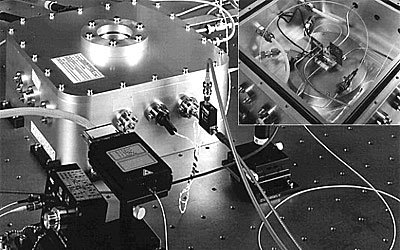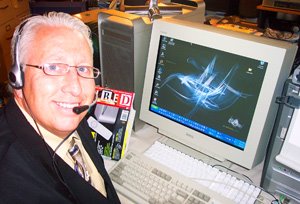Video From Mars!
Nanotechnology traps photons to create a super-sensitive sensor that could allow interplanetary broadband access, such as streaming video from Mars!

Manned missions to Mars would benefit from high-speed communications, even streaming video, rather than the clunky, hours-long image downloads from the likes of the Cassini-Huygens Saturn probe, or the Mars Rovers [Image credit: "Distant Shores", painting by Pat Rawlings].Conventional optical communication can carry such video data, but the lasers needed to transmit a readable signal for interplanetary distances would require far more power than is generally available on power-starved space missions.
This has some researchers looking to single-photon detectors, the ultimate low-light sensors, to make it possible to detect relatively low-power laser signals. So far, however, such detectors have been either inefficient (missing most of the photons sent to them), or too slow for high-bandwidth data transmission.
"The detection of extraordinarily low levels of light with high bandwidth has been a challenge for many years," says Karl Berggren, an electrical engineering professor at MIT who helped develop the new device. "This demonstration illustrates what nanotechnology, and in particular nanofabrication, can do when applied to a problem like this."
Now a nanotechnology-based device called a "photon trap", reported this week in the journal Optics Express, combines efficiency and speed, promising to make such interplanetary communication more practical.

Photon detectors have been around for a couple of years, at the heart is a wire 100 nanometers wide that meanders like coils on a refrigerator to increase the area of detection. The wire is cooled to just above absolute zero, at which temperature it becomes a superconductor. When a photon hits the wire and is absorbed, the wire heats up just enough to stop superconducting, creating a detectable jump in resistance [Image of a 1550 nanometer single-photon detector by the National Institute of Advanced Industrial Science and Technology].In the new design, the photons that slip past or reflect off the wire bounce around in the photon trap, giving them more chances to be absorbed by the wire. The trap, with a little help from an antireflective coating, approximately tripled the efficiency of previous detection efforts.
The efficiency is "a huge jump forward," says Jeffrey Stern at the Jet Propulsion Laboratory. Indeed, he says this efficiency is enough for optical communication in space.
Note from Technophile: One engineering hurdle remains before the sensors are ready for such applications, however. Although devices have already been built and tested, because they are so small, focusing the photons on them is a challenge. This problem is expected to be solved within two years.Source: [Technology Review]




















0 Comments:
Post a Comment
<< Home